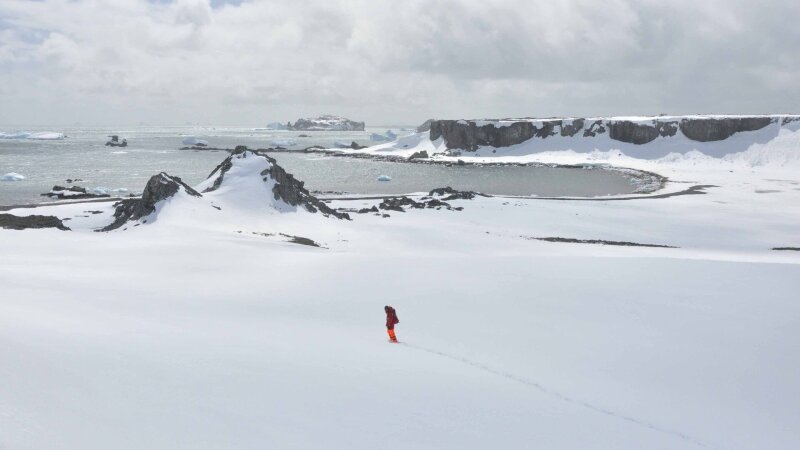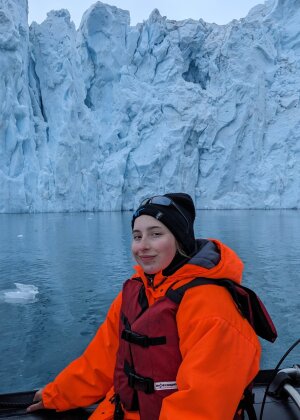
- Research
Published: | By: Irena Walinda
A team from the University of Jena has now confirmed a feared trend: after the H5N1 avian influenza (bird flu) virus was detected on the sub-Antarctic island of South Georgia in October 2023 and subsequently on James Ross Island in Antarctica in February 2024, researchers led by Christina Braun documented signs of the highly pathogenic variant also occurring on the Fildes Peninsula on King George Island for the first time during their most recent expedition in 2025. The researchers observed increased mortality among various seabird species.
A team member of the Polar and Ornithological Ecology research group|working group|study group|task force during an expedition on the Fildes Peninsula on King George Island in Antarctica.
Image: Christina Braun (Universität Jena)Unique long-term project since 1979
Under the guidance of Christina Braun, who has already undertaken 15 research trips to the Antarctic, students Julia Engelhardt and Katharina Engl carried out the monitoring at the Uruguayan research station »Base Cientica Antárctica Artigas« from the beginning of January to the end of February 2025. Since 1979/80, German biologists and, since 1983 the Polar and Ornithological Ecology research group at the University of Jena have been observing the development of 14 breeding bird species in a 35 km² area. These include chinstrap, Adélie and gentoo penguins as well as skuas and giant petrels.
The project, funded by the Federal Environment Agency, is considered a unique long-term study worldwide. In addition to population data on birds and seals, the scientists are also recording washed-up waste—including burnt plastic, packaging and fishing debris. This year, the density was around one object per metre of coastline. This is a comparatively high value for a place that is practically uninhabited by humans.
52 dead animals in just one season
Usually, researchers only find a few dead animals during their two- to three-month expeditions, but during the last monitoring period, 52 dead animals were found, mostly skuas (a type of predatory gull), which had died days or weeks earlier. Researchers from the Alfred Wegner Institute in Potsdam and Chilean colleagues took and analysed some of the samples on site and confirmed the suspicion of H5N1.
The research team fears that the virus will continue to spread, as the birds breed in a very confined area—only around 2% of the Antarctic surface is ice-free. »The area we are observing is very small and rich in bird life. In addition, Antarctic birds typically breed in colonies. The risk of infection is therefore significant. If the mortality rate is very high in a population, it may collapse completely,« says Markus Bernhardt-Römermann from the Institute of Ecology and Evolution.
The researchers had to wear special protective clothing due to the risk of the virus being transmitting to humans. In Chile, Peru and Argentina, H5N1 has already spread to mammals such as seals, sea lions and elephant seals, which led to mass deaths on the coasts there in 2023. »Individual infections in humans following direct contact with infected birds have also been documented. Scientists must therefore be very careful and protect themselves,« says Braun, explaining the situation on the ground.
Climate change alters species composition
Antarctic bird species are also sensitive to global warming. »The species composition is shifting rapidly,« the researchers declare. Cape petrels, for example, which were still breeding in their hundreds in the study area just a few years ago, have now virtually disappeared. Not a single breeding pair was found in the current season. In contrast, giant petrels and gentoo penguins, which originally favoured sub-Antarctic regions, are benefiting from the changed conditions. Adélie and chinstrap penguins, on the other hand, are declining rapidly.
»We don’t know whether the birds are seeking out other breeding grounds or actually disappearing—there is a lack of comparable long-term data from other research groups,« emphasizes Braun. »This is precisely why ongoing projects like ours are so important.«
Research with students
Student Julia Engelhardt supported the work of the research team in Antarctica during the 2024/25 expedition.
Image: Christina Braun (Universität Jena)For years, the polar ecology team has has included students from the English-taught Master’s degree programme Evolution, Ecology and Systematics at the Faculty of Biological Sciences. The students support the work on site for two to three months. The team covers around 15 kilometres on foot every day, documenting bird and seal populations and collecting rubbish. »Working on King George Island provides us students with a unique opportunity to collect data and samples from animals that rarely come into contact with humans. Through international cooperation, we also learn more about effective communication and coordination within scientific teams,« reports Julia Engelhardt.
Outlook
The researchers and students from Jena will continue to document the long-term impact of bird flu on Antarctic wildlife. Another team from Jena will set off for Antarctica in November to resume monitoring.
Contact:


